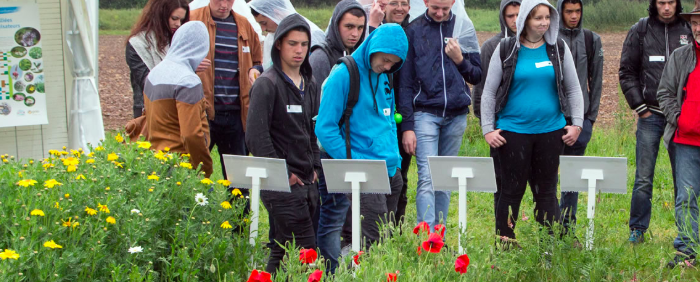
The meadows where the cows graze peacefully seem very “natural” to us. However, the farmer-breeder had to choose and sow seeds to ensure a quality pasture. At the 9th Gnis Biodiversity Day, May 12, 2016, Julien Greffier, Forage Product Manager at LG Seeds, was our guide. He explained to us how the farmer must make wise choices to combine yield, good digestibility and nutritional quality of the forage, according to the needs of his animals as well as the soil and climate conditions of the farm.
Know the right plants for a quality diet
Contrary to popular belief, there is a real dynamic in the management of forage biodiversity. Prospecting campaigns still exist, but it is mainly the improvement of plants from collections of genetic resources which has been progressing since the 1960s. Breeders have characterized plants for their growth period, their port, their energy content and their nitrogen, their tolerance to diseases according to climates and terrain.
14 species and 600 forage varieties available
“It takes 10 to 15 years to select a forage variety … It is already 3 years to register it in the French Official Catalog of species and varieties and a few years to reproduce it in sufficient quantities to market. A plant candidate for a breeding program in 2016 will, at best, be marketed in 2035, “ says Julien Greffier. Hardiness – less water, fewer inputs like nitrogen fertilizer – and disease tolerance are the most important criteria, with, of course, yield. The tour of the 40 mini-plots makes it possible to recognize and distinguish the grasses (energy source) of the legumes ( protein source).
English ryegrass, pasture Rolls Royce
“Very ripe in the prairies for 50 years, the perennial ryegrass is an appetizing grass for animals, rich in energy and very tolerant of trampling. The breeders have developed varietiesthat tolerate rust, a fungus, because animals do not graze the meadows contaminated. “
There are 140 varieties of English Ryegrass, with improved yields and a wide range of early maturity to suit different regions.
“In contrast to the perennial ryegrass, there is the Italian ryegrass, the” formula 1 “grasses, because it grows very fast. It is used to forage because of its erect habit and low water content. By crossing the two, breeders have obtained a variety of hybrid ryegrass varieties .
The “4×4” of grasses is tall fescue
Indeed, it is a very rustic species that adapts to all terrains. It is tolerant to drought and it pushes on the whole season. Initially, it had very stiff leaves and was not appreciated by the animals. Since the 1990s, breeders have favored soft -leaf varieties that arevalued by animals. Tall fescue is more suitable for feeding meat animals than milk-producing animals because the energy content remains lower than that of the perennial ryegrass.
Legumes: clover, alfalfa, trefoil, sainfoin..
“After the 2008 oil crisis, farmers started growing legumes again to produce and provide the protein needed for the proper growth of their animals. Since then, the craze has not abated and breeders mix legumes that can grow harmoniously with grasses, “ says Julien Greffier.
Dwarf white clover, intermediate or giant, rich in nitrogen, drought resistant Alexandria clover and cultivated after cereal mixtures harvested at the beginning of May, clover incarnate in vegetal cover the winter …. But also the trefoil, very widespread in the permanent meadows which does not have many needs and which adapts in the least rich lands. Or the sainfoin that grows mainly in limestone and is less greedy water. “These last two legumes also contain tannins that promote the assimilation of proteins by minimizing the accumulation of gas in the rumen during rumination. A cow, for example, who consumes too much legume can have an abnormal and dangerous swelling.
But the protein champion remains alfalfa. Thanks to a pivot root, she can fetch water several meters deep and produces up to 2 tons of protein per hectare!
Nice article, i like it!